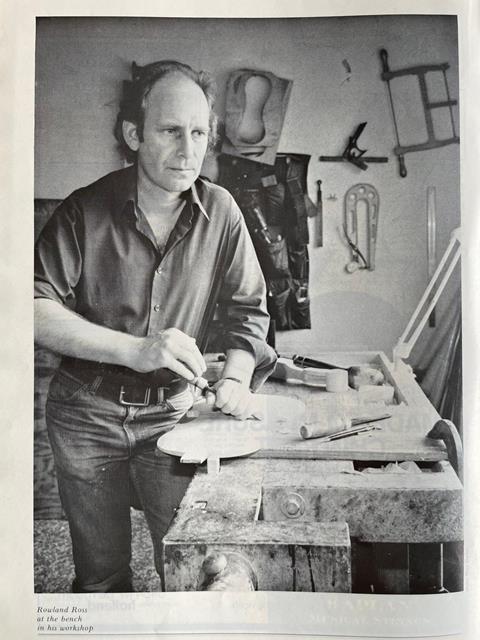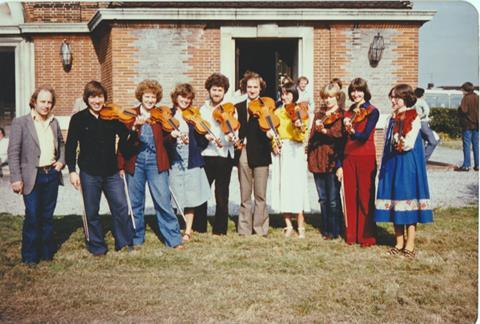Martin Restall and Ninian Boyle look back on the life of the British violin maker, who died in March 2024 aged 79

Discover more lutherie articles here
Rowland Ross, one of the most gifted violin makers of our age has sadly passed. He was best known for his contribution to the Baroque Music revival in the 1980s and 90s with his beautiful copies of master instruments by Nicolo Amati and other fine makers of the golden age of violin making.
Rowland was educated in Godalming in Surrey in the post-war period and became apprenticed as an art iron worker in Haslemere. Once qualified he took a job in Germany and after a couple of years returned to Britain where he met his wife to be, Jill. They married in 1968 and at this time Rowland went to work at Elstead Forge in Surrey, England where he was employed for several years.

Unfortunately he developed problems with his back and it looked as if his life in iron work was over. A career change became necessary and as luck would have it, around 1970 he met Michael Heale the viol maker, who was at the time engaged in creating early instruments. He showed Rowland the ropes and then commissioned him to make viols. Rowland showed his natural flair and creativity and began to add Baroque violins, violas and cellos to his portfolio. A move back to Cowplain in Hampshire gave him a dedicated workshop in his house and here he stayed with his family until his passing.
Fortuitously, Rowland met Roddy Skeaping the Baroque violinist at around this time, who was at the heart of a big revival in early music. Rowland made a great impression on Roddy, who helped to promote his work among players and so he rode the wave of this interest, and demand for his superb instruments sky-rocketed. Rowland made in excess of 260 instruments during his working life and among his customers were illustrious names such as Roy Goodman, and Monica Huggett. Rowland had instruments in all the well-known Baroque ensembles of the time.

Rowland Ross appeared in the September 1983 issue of The Strad
He not only had a prodigious output of instruments, he also found time to do a little teaching and lecturing. He was a regular at the Dartington Violin Makers Conference every year and was also a founder member of the British Violin Makers Association. We met Rowland in the early 1980s and we ourselves benefited from Rowland’s generosity of time and information and he always showed a keen interest in our work as he cast a critical eye over one of our latest offerings. As with most violin makers, he spent a lot of time researching varnish and varnishing materials and worked on the analysis of classical violin varnishes alongside scientists at the University of Cambridge and willingly sharing his acquired knowledge.
Rowland was happy to collaborate with us and to share his ideas. He was incredibly busy back then, with a four-year(!) waiting list for his instruments, but was always generous with his time and full of encouragement. We learnt much from him, exchanged ideas and researched varnishes together. We all cooked concoctions in the garden and tried in vain to use Propolis successfully!
We were impressed by his keen eye and natural sense of shape. His ideas on scrolls were influenced by his time as a blacksmith making scrolls in ironwork. Rowland’s arching was carefully thought through and he had a great understanding as to what worked; he never slavishly copied. There is to be found in his work an elegance due to his innate understanding of shape and curves. His Amati copies are particularly convincing and this was his favourite form.
He had a great understanding as to what worked; he never slavishly copied
Everything he did was carefully researched and his ideas were always backed up with convincing arguments. If you challenged his ideas you needed to know your facts! Thus endured a long and lasting friendship.
Rowland’s instruments were sold worldwide. He made violins for the University of Florida, McGill University and a number of other universities in the United States and Canada. His output can be found in countries as far flung as Great Britain, Scandinavia, several other European countries and Australia. He liked to get feedback from his customers and was sometimes to be found at rehearsals and recording sessions observing how his instruments were performing ‘in the field’. He was never one to stand still and always wished to improve his techniques and knowledge for the benefit of his many clients.
Rowland retired from instrument making in 2012 to concentrate on his hobby of photography, a subject in which he proved to be every bit a skilled as he was in violin making. He has left a great legacy of instruments and a great gap in the life of his friends and family and will be sorely missed.
Rowland Ross RIP
Born 19 January 1945
Died 6 March 2024
Martin Restall and Ninian Boyle
Read: Celebrating Women Luthiers exhibit at Reuning & Son Violins
Read: Obituary: violist Patrick Ireland (1923 - 2024)
Discover more lutherie articles here
An exclusive range of instrument making posters, books, calendars and information products published by and directly for sale from The Strad.
The Strad’s exclusive instrument posters, most with actual-size photos depicting every nuance of the instrument. Our posters are used by luthiers across the world as models for their own instruments, thanks to the detailed outlines and measurements on the back.
The number one source for a range of books covering making and stringed instruments with commentaries from today’s top instrument experts.
American collector David L. Fulton amassed one of the 20th century’s finest collections of stringed instruments. This year’s calendar pays tribute to some of these priceless treasures, including Yehudi Menuhin’s celebrated ‘Lord Wilton’ Guarneri, the Carlo Bergonzi once played by Fritz Kreisler, and four instruments by Antonio Stradivari.






































No comments yet